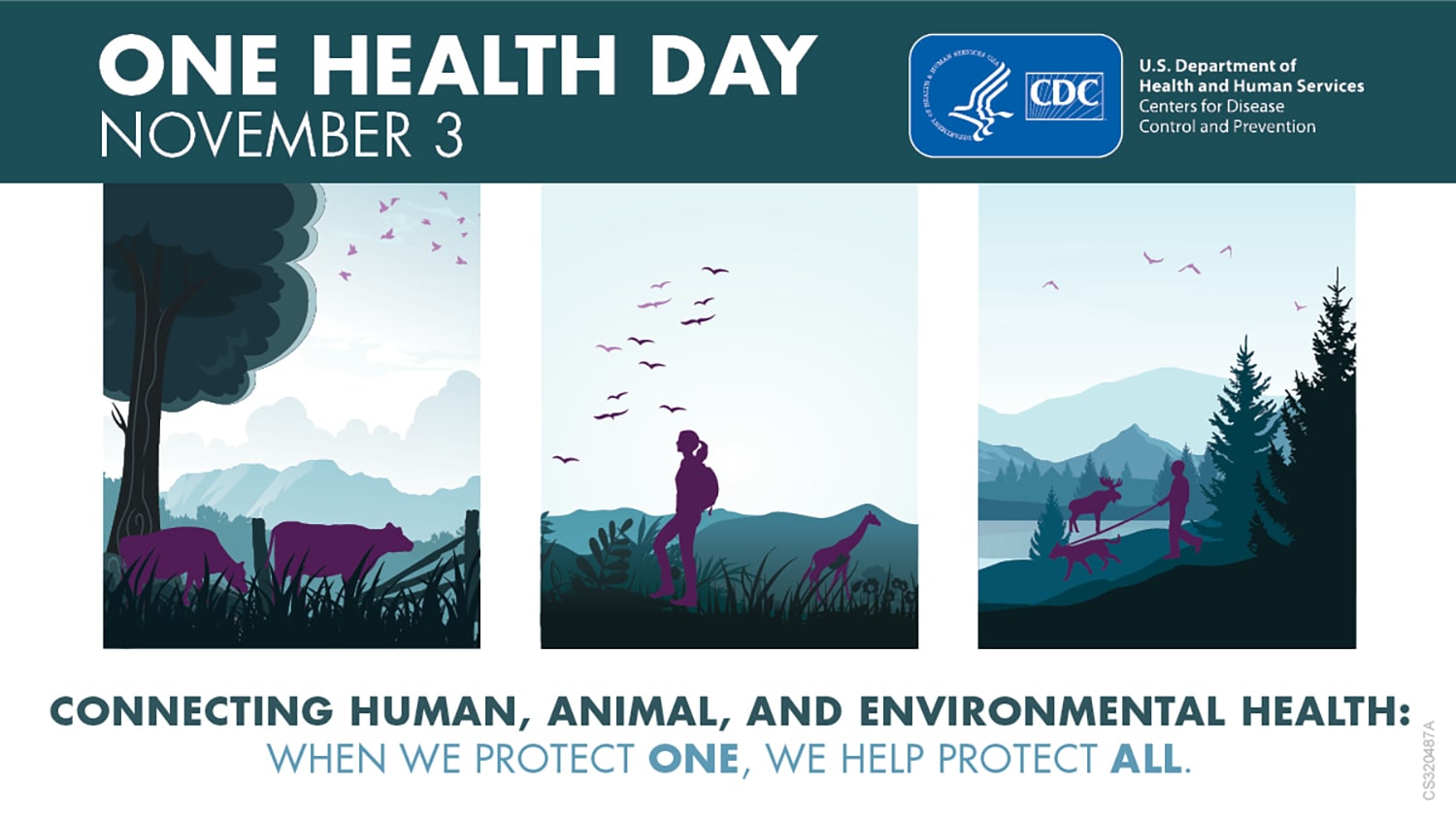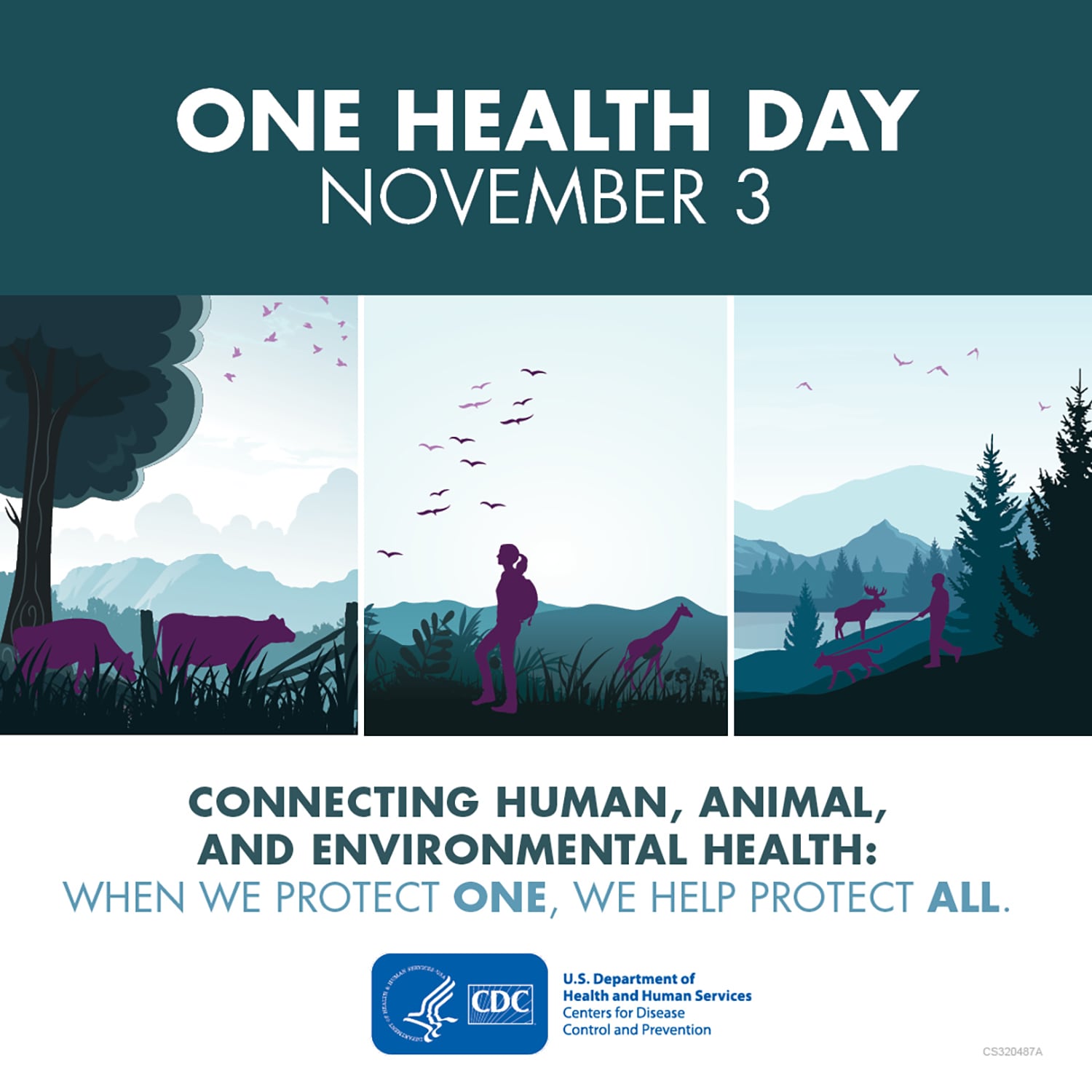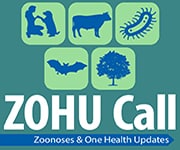One Health Day

November 3, 2023, marks the eighth annual One Health Day, a global campaign that celebrates and brings attention to the need for a One Health approach to address shared health threats at the human-animal-environment interface. A One Health approach can address a wide range of public health concerns like antimicrobial resistance, environmental health, food safety, mental health, vector-borne diseases, zoonotic diseases, and much more.
One Health is a collaborative, multisectoral, and trans-disciplinary approach — working at the local, regional, national, and global levels — with the goal of achieving optimal health outcomes recognizing the interconnection between people, animals, plants, and their shared environment. (US Government Definition, established 2017).
One Health Day provides an opportunity for experts and the community to join together in One Health education and awareness. Communication, coordination, and collaboration among partners working in animal, human, and environmental health as well as other relevant areas are an essential part of the One Health approach. Working together allows us to have the biggest impact on improving health for people, animals, plants, and our shared environment.
You can celebrate One Health Day every day by committing to working with experts in other sectors to achieve better health outcomes for all.
Join us in celebrating One Health Day
- Follow @CDC_NCEZID on X (Twitter) and spread the word using #OneHealthDay
- Use One Health graphics on your websites and in social media
- Join CDC’s monthly Zoonoses and One Health Updates (ZOHU) Call
- Encourage and engage in communication, collaboration, and coordination with partners across human, animal, and environmental sectors
- Learn more about CDC’s One Health work
Social Media Graphics
X (Twitter)/Facebook
See the One Health Resource Library for more graphics, guidance, and other One Health resources.
Key Messages
- One Health is an approach that recognizes the interconnection between people, animals, plants, and their shared environment.
- One Health is a team sport. A successful One Health approach to public health involves many experts working together to improve the health of people, animals — including pets, livestock, and wildlife – plants, and the environment.
- One Health is not a new concept, but it has become more important in recent years. A One Health approach can help address many kinds of public health threats, including zoonotic diseases, antibiotic resistance, vector-borne diseases, food safety and security, chronic disease, mental health, and more.
- Zoonotic diseases can be spread between animals and people. More than half of all infections that people can get are zoonotic.
-
- Many factors have changed interactions between people, animals, plants, and our environment.
- Human populations are growing and expanding into new geographic areas. People are living in closer contact with wild and domestic animals, including livestock. Closer contact provides greater opportunity for diseases to pass between animals and people.
- The earth has experienced changes in climate and land use. These disruptions in environmental conditions and habitats provide opportunities for diseases to pass to animals.
- The movement of people, animals, plants, and animal/plant products has increased from international travel and trade. This movement provides greater opportunity for diseases to spread across borders and globally.
- Three in four emerging infectious diseases come from an animal. Fighting emerging infectious disease threats requires One Health collaboration across the human health, animal health, and environmental spectrum.
- Recent global health events, including the COVID-19 pandemic and mpox outbreak, are examples of diseases emerging as a result of close contact between animals and people. A One Health approach recognizes the close connection between the health of people, animals, and the environment and the role this connection plays in the spread of diseases.
- Pets are an important example of One Health.
- Pets provide us with companionship, entertainment, and comfort, which can have important effects on our physical and mental wellbeing. However, pets can sometimes carry harmful germs that can make us sick even when the pet appears healthy.
- Keeping our pets healthy helps to keep us healthy and happy as well.
- Communication, coordination, and collaboration among partners working in animal, human, and environmental health as well as other relevant areas are an essential part of the One Health approach. Working together allows us to have the biggest impact on improving health for both people and animals living in a shared environment. No one person, organization, or sector alone can effectively address diseases at the human-animal-environment interface alone.
- A One Health approach works because it addresses health threats from all possible angles: human, animal, and environmental. By protecting one, we help protect all.
Sample Social Media Messages
X (Twitter)
November 3 is #OneHealthDay. A #OneHealth approach helps achieve the best health for people, animals, and our shared environment. Learn more: bit.ly/CDCOHDay
Tomorrow is #OneHealthDay. #OneHealth recognizes that human, animal, and environmental health are connected. By protecting one, we help protect all. Learn more: bit.ly/cdcOneHealth
Today is #OneHealthDay. As our world becomes more connected, the need for #OneHealth increases. Together, we can prevent the next pandemic & protect health for all: bit.ly/cdcOneHealth
A #OneHealth approach can help to address everything from #AntimicrobialResistance to zoonotic diseases.
Learn how One Health applies to many aspects of our lives: bit.ly/OHBasics #OneHealthDay
#OneHealth is a team sport. We can protect human health, animal health, and our shared environment by working together. Learn more: bit.ly/cdcOneHealth #OneHealthDay
Recognizing the connections between people, animals, and our shared environment means we can solve problems threatening us all. A #OneHealth approach can make the world a safer, healthier place. Learn more: bit.ly/cdcOneHealth #OneHealthDay
Facebook
Today is One Health Day. Learn how a One Health approach to public health can bring experts together to improve the health of people, the environment, and animals, including pets, livestock, and wildlife. Learn more: bit.ly/CDCOHDay
Did you know that more than half of all infections people can get can be spread by animals? In celebration of One Health Day this year, learn how a One Health approach to public health can lead to healthier people, animals, and environment. Learn more: bit.ly/cdcOneHealth
Today is One Health Day. A One Health approach can help solve many public health issues, from antimicrobial resistance to food safety and security. We can work together to make a healthier world for people, animals, and our shared environment. Get One Health resources here: bit.ly/cdcOneHealth
The goal of One Health is to recognize the connection between people, animals, plants, and our shared environment, so we can better work together to achieve the best health outcomes for all. Learn more: bit.ly/cdcOneHealth
COVID-19 is just one example of a disease resulting from close contact between animals & people. A One Health approach recognizes the connection between people, animals, & environment, and how this contributes to the spread of disease. Learn more: bit.ly/cdcOneHealth
Have you heard of One Health? One Health is the idea that human, animal, and environmental health are closely connected. When we protect one, we help protect all. Tap the link to learn more. #OneHealth #OneHealthDay #PublicHealth LINK: bit.ly/cdcOneHealth



